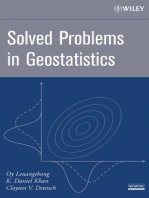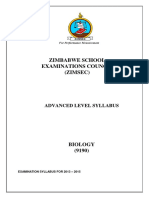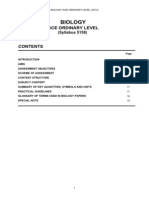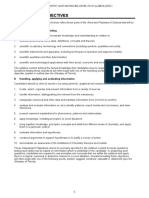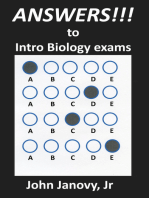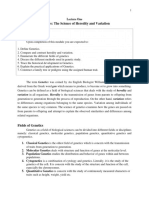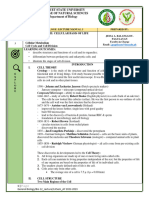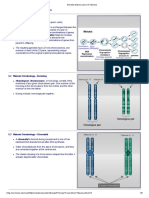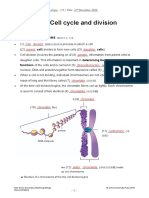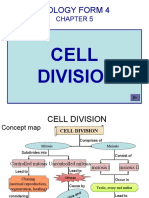Biology f3 Syllabus
Biology f3 Syllabus
Uploaded by
catoff_89Copyright:
Available Formats
Biology f3 Syllabus
Biology f3 Syllabus
Uploaded by
catoff_89Copyright
Available Formats
Share this document
Did you find this document useful?
Is this content inappropriate?
Copyright:
Available Formats
Biology f3 Syllabus
Biology f3 Syllabus
Uploaded by
catoff_89Copyright:
Available Formats
SEC Syllabus (2012): Biology
SEC SYLLABUS (2012)
BIOLOGY
SEC 04
SYLLABUS
SEC Syllabus (2012): Biology
Biology SEC 04 Syllabus
Introduction 1.
Available in September (Paper I and Paper II B only) Paper I (2hrs) + Paper II (2hrs) + Practical
This syllabus places much emphasis on understanding biological principles and the techniques for studying them rather than on knowledge of descriptive detail and technical terms. In fact, the syllabus implies that candidates will spend more time on practical work, which will aid understanding, rather than on learning to recall biological facts. It is expected that candidates will be familiar with the skills necessary for practical work. This is why, at various sections of the syllabus, practical work is indicated as an integral part of the course. The course incorporates personal, social, political, economic, technological and environmental aspects of biology. It is expected that where possible the teaching of biology treats these considerations with particular reference to Maltese situations. To achieve this, various syllabus items refer to locally occurring organisms as well as local situations to illustrate biological principles. Live animals may be brought in the laboratory for study provided that they are kept unstressed in suitable conditions and should whenever possible be returned unharmed to their habitats. Nothing in this syllabus requires candidates or teachers to kill animals. Studies of organisms in their natural habitats should aim to minimal disturbance. Mammalian organs, which may be required for dissection, should be obtained from the abattoir or butchers.
2.
3.
Aims A course based on the following syllabus should enable candidates to: (a) (b) (c) (d) (e) (f) (g) (h) (i) develop an awareness of various forms of life (particularly locally occurring) and promote a respect for them; develop a knowledge and understanding of basic anatomical and physiological characteristics of organisms; become aware of the interactions (i) between organisms, and (ii) between organisms and their environment; become aware of the role that humans have in the conservation and destruction of the environment; become aware of the personal, social, political, economic, technological and environmental implications of biology; develop a scientific approach to problem solving which includes the assessment and interpretation of experimental data; acquire a range of manipulative and communicative skills appropriate to biology; develop a working knowledge of other fields of study (e.g. mathematics, chemistry, physics, geography etc.) which are necessary for a proper understanding of biological concepts; and obtain a worthwhile educational experience, whether or not they intend to study biology beyond this level or pursue a career requiring knowledge of biology.
Assessment Objectives The examination will be designed to assess the candidate's ability to: (a) Demonstrate knowledge and understanding of: i. biological facts and principles and use of appropriate terminology; ii. appropriate practical techniques and safety precautions; iii. the personal, social, political, economic, technological and environmental applications of biology particularly in the Maltese society.
SEC Syllabus (2012): Biology
(b) Acquire skills in: i. formulating hypotheses, designing and conducting simple experiments to test them; ii. making constructive criticisms of experimental designs; iii. planning and conducting simple experiments to test given hypotheses; iv. making, recording and communicating accurate observations in the form of tables, charts, graphs, diagrams and concise logical prose; v. interpreting data represented in tables, charts, graphs, diagrams, and photographs; vi. applying elementary mathematics, chemistry and physics to biology; and vii. problem solving by applying biological knowledge and understanding to problems, including those of a personal, social, political, economic, technological and environmental nature. Required Background 1. Candidates are expected to be able to: (a) (c) work with decimals and fractions; present numerical data in tables and graphs (line, bar, histograms); and (b) calculate percentages, arithmetic means and simple rates and ratios; (d) interpret numerical information in tables, graphs (line, bar, histograms) and pie charts. 2. Candidates are also expected to be familiar with the following terms and concepts: (a) (c) Energy and its different forms; Evaporation and the effects of temperature, humidity and air currents on its rate. Latent heat of evaporation; Atoms, molecules, ions, compounds, salts, acids, alkalis and pH; and Solubility, concentration gradients, diffusion and osmosis. (b) Heat transfer and insulation;
(d) Relationship between surface area and volume; (e) (f)
Scheme of Assessment The examination will consist of two written papers and an assessment of practical work. The questions will be set in English and must be answered in English. Candidates are reminded of the necessity for good English and orderly presentation in their answers. The examination will be structured as follows: Paper I (55% of the total marks) consists of a written paper (40% of the total marks) and a practical component (15% of the total marks) and is to be taken by all candidates registered for the examination. The written paper of a two hour duration will consist of a number of compulsory short and longer structured questions testing the candidates breadth of knowledge and understanding of the whole subject content as well as a range of skills. Questions may involve the analysis and interpretation of photographs, diagrams, graphs and data as well as the working out of simple mathematical calculations. Questions testing the application of biological principles to everyday situations will be included in this paper. The practical component is assessed separately by a continuous method during the course of instruction. There will be two versions of Paper II: Paper II A or Paper II B, each of a two-hour duration. Questions in Paper II A will be more difficult than those in Paper I. Questions in Paper II B will be easier than those in Paper I. In the September supplementary session only Paper I and Paper II B will be offered. Candidates will be required to indicate on the registration form which option in Paper II (A or B) they wish to sit for. No change in the choice of paper will be allowed after the registration period.
SEC Syllabus (2012): Biology
Paper II A (45% of the total marks) will be divided into two sections and questions may be set on any part of the syllabus. Section A will consist of two compulsory structured questions which will involve the design, planning, and analysis of simple experiments, or the critical evaluation of an investigation or the interpretation of a passage relating to an area of applied biology, or they may test the candidates experience of practical skills. Section B will consist of five structured essay-type questions of which candidates will be required to answer three. Questions will be set to test the candidates knowledge and understanding of biological topics. Paper IIB (45% of the total marks) will consist of eight structured essay-type questions of which candidates will be required to answer four. Content The distribution of syllabus content in the combined papers will be approximately as follows: Syllabus Section Part 1: The Living World Part 2: Keeping Alive Part 3: Living Together The balance will be approximately similar in each of the written papers. The papers will cover the whole syllabus and will test the candidates abilities according to the following scheme: Ability Knowledge Comprehension Application, Analysis and Evaluation Practical Assessment Approx. % of marks Paper I 55 45 Paper IIA or IIB Approximate mark allocations 20% 50% 30%
Approximately equal weighting will be given to the cognitive skills listed in the table above. Practical work (a) 15% of the total marks for this examination are allocated to the practical experience of the candidate. This would be assessed by the schools on the basis of a set of laboratory reports on experiments performed during the candidates course of study. (b) The mark for the practical work is to be based on the average mark of the best 15 experiments. (c) Laboratory Report Books are to be available at the candidates schools for moderation by the Markers Panel. (d) The school assessments should reach the MATSEC Examinations Board on a date stipulated by the MATSEC Board. (e) Private Candidates (i) Private candidates who left school before 1994 will not be expected to present their laboratory report books. Their mark will be obtained by pro-rating of the written papers. (ii) Candidates who studied the subject at school and are re-sitting the subject may carry forward the practical report mark from a previous session. (iii) Candidates who have never studied the subject at school but have covered the coursework privately will be expected to present their coursework to the MATSEC Board by the date indicated by the board. Candidates will be asked to attend for an oral examination about their practical work.
SEC Syllabus (2012): Biology
Results Candidates sitting for Paper I and Paper IIA may qualify for grades 1, 2, 3, 4 or 5. The results of candidates who do not obtain at least a grade 5 shall remain unclassified (U). Candidates sitting for Paper I and Paper IIB may qualify for grades 4, 5, 6 or 7. The results of candidates who do not obtain at least a grade 7 shall remain unclassified (U). Grade Descriptions Grade descriptions are provided to give a general indication of the standard of achievement likely to have been shown by candidates awarded particular grades. The grade awarded will depend upon the extent to which the candidate has met the Assessment Objectives over-all and it might conceal weakness in one aspect of the examination, which is balanced by above average performance in some other. Grade 1 Candidates achieving Grade 1 are expected to demonstrate sufficient knowledge and understanding to make judgements on biological statements. More specifically, candidates are likely to be able to demonstrate the ability to: 1 recall a wide range of biological facts and principles and use appropriate terminology in the subject content from all areas of the syllabus. perform, describe and evaluate a wide range of simple biological experiments with precision and skill, and comment with supporting arguments on the validity of procedure. understand simple safety precautions in laboratory work. recall a wide range of simple applications (namely social, political, economic, technological and environmental) of Biology with emphasis on the Maltese context and explain the principles underlying them. make, record and communicate accurate detailed observations from a wide variety of sources in the form of tables, charts, graphs, diagrams and concise logical prose. The use of apparatus to measure accurately weight, length and temperature is essential. analyse and interpret biological information and data represented in Grade 5 Candidates achieving Grade 5 are expected to demonstrate sufficient knowledge and understanding of a range of biological facts to allow insight into the significance of biological statements or problems. More specifically, candidates are likely to be able to demonstrate the ability to: recall a good range of biological facts and principles and use appropriate terminology in the subject content. perform, describe and evaluate a good range of simple biological experiments with some precision and skill. Grade 7 Candidates achieving Grade 7 are likely to be familiar with simple biological facts to be able to understand straightforward biological statements. More specifically, candidates are likely to be able to demonstrate the ability to: recall the basic biological facts and principles and have limited use of appropriate terminology in the subject content perform and describe a limited range of simple biological experiments.
3 4
understand simple safety precautions in laboratory work. recall simple applications (namely social, political, economic, technological and environmental) of Biology with emphasis on the Maltese context and explain the principles underlying them. make, record and communicate accurate detailed observations from a variety of sources in the form of tables, charts, graphs, diagrams and concise logical prose. The use of apparatus to measure with some accuracy weight, length and temperature is required. analyse and interpret simple biological information and data
understand simple safety precautions in laboratory work. recall simple applications (namely social, political, economic, technological and environmental) of Biology with emphasis on the Maltese context.
make simple observations from a variety of sources in the form of tables, charts, graphs, diagrams and concise logical prose. The use of apparatus to measure weight, length and temperature is required. draw simple references from biological information and data.
SEC Syllabus (2012): Biology
tables, charts, graphs, diagrams and photographs. 7 use a knowledge of biological processes and principles in familiar situations, apply it to unfamiliar situations and formulate hypotheses. apply a wide range of chemistry and physics when dealing with biological processes and principles and elementary mathematics to carry out necessary calculations. use a wide range of biological terms accurately all throughout their work when communicating biological information. present a wide range of biological information in a variety of ways. describe links between related phenomena.
represented in tables, charts, graphs, diagrams and photographs. use a knowledge of biological processes and principles in familiar situations, and apply it to unfamiliar situations. apply essential chemistry and physics when dealing with biological processes and principles and elementary mathematics to carry out the necessary calculations. use essential biological terms accurately throughout most of their work when communicating biological information. present biological information in a variety of ways. describe links between simple related phenomena. use a knowledge of biological processes and principles in familiar situations. apply some elementary chemistry and physics when dealing with biological processes and principles and sufficient mathematics to carry out simple calculations. use sufficient biological terms accurately when communicating biological information. present biological information in a straightforward manner. understand the links between simple related phenomena.
10 11
The Syllabus Part 1: The Living World Topic a. Characteristics of living things Subject content Characteristics common to organisms. The cell as the basic unit of life. Knowledge expected The vital functions as criteria for distinguishing between living and non-living things. Study of the eukaryotic cell should be confined to the function of the nucleus, the cytoplasm, the cell membrane and the mitochondrion. Candidates are expected to know how to draw simple diagrams of a typical animal cell and a typical plant cell as seen under the light microscope. b. Different forms of life The evolutionary development of unicellular life forms into multicellular life forms. The concept of division of labour in multicellular organisms. Surface area to volume ratio in relation to problems of increased size in multicellular organisms. Candidates are expected to know how to calculate the surface area to volume ratio of a cube.
The groups listed below are intended to familiarise the candidate with the various main groups of living organisms. Only the major physical characteristics of the group are required. Details of physiology and life cycles will not be required. Candidates should also be able to name (vernacular names are sufficient) an organism as an example for each group. Whenever possible, locally occurring organisms should be cited. Viruses Viruses as being borderline between living and nonliving. Outline structure of viruses (i.e. genetic material surrounded by a protein cover) as differing from the usual cellular structure of living things. Outline structure of a bacterium as an example of a
The bacteria kingdom
SEC Syllabus (2012): Biology
prokaryotic cell. The protist kingdom The fungus kingdom The plant kingdom Outline structure of a unicellular plant-like and a unicellular animal-like protist. Outline structure with reference to a unicellular and a filamentous fungus. Cellular and functional features characteristic of plants.
The characteristics of the following plant groups should illustrate the evolutionary development from an aquatic environment to a terrestrial existence. General characteristics of the following groups: Bryophytes (as exemplified by mosses) Plants having a very simple structure (thallus) having no proper roots, leaves and stems. Hair-like structures (rhizoids) on the lower surface to absorb moisture. Size limited by the absence of vascular tissue. Spread limited because of a heavy dependency on water (no means of preventing water loss and reproduction requires a watery medium). Plants having roots, stems and leaves. Because they possess vascular tissue, ferns can attain considerable sizes. A waxy layer allows them to colonise drier areas, however reproduction still requires a damp environment. Plants that are able to conserve water. They reproduce by seeds that are formed in cones. This group is also called Gymnosperms (naked seeds) because the seeds are not enclosed in an ovary. Plants whose seeds are formed within the ovaries of flowers. There are two main groups: i. Monocotyledonous plants: tend to have a fibrous root system, long parallel-veined leaves, floral parts in multiples of three and a seed having one cotyledon ii. Dicotyledonous plants: tend to have a tap-root system, broad net-veined leaves, floral parts are often grouped in groups of fours or fives, and a seed having two cotyledons The animal kingdom Cellular and functional features characteristic of animals
Pteridophytes (as exemplified by ferns)
Conifers
Flowering plants (angiosperms)
The characteristics of the following animal groups should illustrate the evolutionary development from an aquatic environment to a terrestrial existence. General characteristics of the following groups: Coelenterates (Cnidarians) Animals that have a sac-like body with a single opening surrounded by tentacles armed with stinging cells. They live in a watery environment. Due to the absence of a circulatory system, the body of these animals is thin and flat to facilitate the diffusion of oxygen. Many are animal parasites. Animals that have a long thread-like body, round in cross-section. Some live in soil, but many are plant or animal parasites.
Flatworms (platyhelminthes): Roundworms (nematodes)
SEC Syllabus (2012): Biology
Segmented worms (annelids) Molluscs
Animals that have a long segmented body and a digestive tract with a mouth and anus. Animals that have a soft unsegmented body. Most have an external or an internal shell. They live in aquatic or moist environments. Animals that have a segmented body covered by a hard cuticle (exoskeleton) that is shed and replaced by a new one when the animal outgrows it (moulting). They have jointed appendages. The phylum includes Crustaceans, Insects, Myriapods and Arachnids in which the number of legs is a major distinguishing feature. Insects as a group of Arthropods having a body divided into a head, a thorax and an abdomen, three pairs of jointed legs and generally two pairs of wings. Their waterproof exoskeleton made them very successful in terrestrial environments. Development involves either a complete (egg, larva, pupa, adult) or an incomplete (egg, various instars/nymphs, adult) metamorphosis (details of life cycles are not required).
Arthropods
Vertebrates
Animals that have a vertebral column extending to form a tail. Have an internal skeleton usually made up of bone. The group is divided into five classes: i. Fish: vertebrates adapted for an aquatic environment having a streamlined body with fins, gills and scales covering the body. They are ectothermic. Candidates are expected to know how to draw a simple diagram of a typical bony fish showing its major characteristics. ii. Amphibians: have thin moist skins without scales. They are adapted for a terrestrial environment, but have to return to water to lay eggs. They are ectothermic. iii. Reptiles: very successful terrestrial vertebrates with dry scaly skins. They lay eggs on land in leathery shells. They are ectothermic. iv. Birds: have a body covered with feathers. Their forelimbs are modified into wings; they have toothless beaks and lay eggs in hard protective shells. They are endothermic. v. Mammals: have a body covered with hair. They have mammary glands that produce milk, external ears and a diaphragm separating the thorax from the abdomen. They are endothermic.
c. Grouping living things
The standard system of classifying and naming organisms. The use of identification keys.
The emphasis should be on the advantages of having a standard classification / naming system, rather than on the recall of nomenclature. The use of identification keys should aim at developing observation skills.
SEC Syllabus (2012): Biology
Part 2: Keeping Alive Topic a. The chemicals of life Subject content Composition and properties of carbohydrates, lipids and proteins. Knowledge expected Composition should include knowledge of elements present. An appreciation of monosaccharides, fatty acids and glycerol and amino acids as structural components of polysaccharides, lipids and proteins respectively. Candidates are expected to have performed a chemical test for each of the following: reducing sugar, starch, lipid and protein. Carbohydrates as an energy source and as the main constituent of plant cell walls. Starch and glycogen as the main carbohydrate storage in plants and animals respectively. Lipids as efficient energy stores. In mammals, fat layers under the skin and around certain organs offer protection and heat insulation. Lipids are a constituent of cell membranes. Proteins are needed for growth and repair of cells and as enzymes. Candidates should be aware that excess protein is deaminated in the liver. Sources and functions of vitamins A, C and D in a human diet. Mineral salts requirements of organisms. The importance of water in organisms. Vitamins as essential components in the diet for the normal functioning of the body. Sources and functions of vitamins A, C and D (and the associated deficiency symptoms) in humans. Functions of nitrogen and magnesium in plants. Sources and functions of calcium, phosphorus and iron in humans. Water needed as a reactant in certain metabolic reactions, as a medium for chemical reactions occurring in solution and for the transport of substances in solution. A diet containing the right balance of the different foods that meet the hanging needs of individuals. These needs are dependent on the lifestyle, activity and developmental stage of an individual. The activity and characteristics of enzymes should be investigated through simple controlled experiments with a suitable enzyme. Economic uses of enzymes should include biological washing powders and the production of cheese. Candidates are expected to be familiar with simple experiments to demonstrate diffusion and osmosis. A simple consideration of respiration with emphasis on the comparative release of energy (as ATP) from both types of respiration. Candidates are expected to have performed simple controlled experiments to demonstrate the production of carbon dioxide and heat from the respiration of yeast, germinating seeds and small animals.
A balanced diet in humans.
General characteristics of enzymes and their role in metabolic reactions.
Movement of substances in and out of cells: diffusion; osmosis; active transport. b. Getting energy from food Aerobic and anaerobic respiration.
SEC Syllabus (2012): Biology
Economic importance of products derived from anaerobic respiration of certain microorganisms. Anaerobic respiration in muscle cells. Characteristics of respiratory surfaces.
The use of alcoholic fermentation by yeast in bread making, beer and wine production. The use of bacteria to produce biogas (methane), vinegar and lactic acid for yoghurt, butter and silage production The production of lactic acid and the resultant oxygen debt due to the anaerobic respiration of muscle cells. Candidates should appreciate that the characteristics of different respiratory surfaces vary due to the complexity and the surrounding environment of the respective organism. Different respiratory surfaces share common characteristics to increase the efficiency of gaseous exchange and transport. Candidates are expected to use simple diagrams and sketches to explain how gaseous exchange occurs in the organisms cited. Detailed diagrams of the respiratory systems are not required. Health hazards due to smoking should mention lung cancer, bronchitis, emphysema and the dangers of passive smoking. Examples of air pollution should include carbon monoxide, carbon dioxide, sulphur dioxide, oxides of nitrogen and lead as components of smoke produced from the burning of fossil fuels in power stations, industry and motor vehicles. The use of chimney filters and catalytic converters to reduce pollution.
Gaseous exchange in a protist, in an insect, in a fish, in a human and in a flowering plant. Health hazards associated with breathing: smoking and air pollution.
c. Conditions supporting life
Abiotic and biotic factors as conditions supporting life. Abiotic factors should include: Availability of water (i) Transpiration and adaptations of plants to reduce water loss. (ii) The importance of osmoregulation as exemplified by the activity of the contractile vacuole in a named protist and the kidney in humans. Temperature (i) Major temperature variations on Earth (polar, temperate and tropic regions) and their effect on the distribution of vegetation. (ii) Temperature control in humans.
Abiotic and biotic factors limit the population size and spread. Candidates should appreciate that the uncontrolled growth of any species has negative effects on the environment and the survival of the same species.
Candidates are expected to have performed experiments investigating environmental factors that affect the rate of transpiration. Structure of the human urinary system including the kidney, nephrons and associated blood vessels. Ultrafiltration, selective reabsorption of glucose, mineral ions and water (candidates are expected to use simple diagrams and sketches to explain how these processes occur). The major constituents of urine.
Only an appreciation of the fact that the type of vegetation is influenced by temperature need be considered.
Structure of the skin and its role in temperature regulation. Candidates should appreciate the characteristics of endothermic (homoiothermic) animals, such as humans, and ectothermic (poikilothermic) animals.
10
SEC Syllabus (2012): Biology
Response of plants to abiotic factors
Positive phototropism of stems, geotropism of roots and stems. Candidates are expected to be familiar with simple controlled experiments demonstrating these tropisms.
Biotic factors should include: (i) predator-prey relationships Candidates should be able to illustrate these principles through specific examples, ideally taken from the local environment. Candidates should be able to illustrate these principles through specific examples, ideally taken from the local environment. Adaptations of a named parasite to its parasitic mode of life. Mutualism as demonstrated by the relationship between gut flora and herbivorous mammals, and rootnodule bacteria and leguminous plants. Principles, use and implications of biological pest control. Human population Candidates should appreciate that the great increase in the human population is mainly the result of its success in controlling most of the abiotic and biotic factors controlling it. Detail about differing Birth and Death Rates is not required. An appreciation of the need for an efficient transport system as the organism increases its complexity and body functions are carried in localised areas. Internal anatomy of stems and roots to show the distribution of vascular tissue. (Detailed knowledge of cell structure is not required). Candidates are expected to use simple diagrams and sketches to explain how water is absorbed at the roots and is transported up the stem. Map of the human circulatory system with the names of the major blood vessels to and from the heart (and its valves), lungs, liver and kidney. Structure and functioning of the heart, arteries, veins and capillaries (no histological details are required). Candidates are expected to have performed investigations on the variation of heartbeat under different conditions. The dissection of a mammalian heart to illustrate heart structure is suggested. Body fluids: blood, tissue fluid and lymph. Co-ordination of body functions in humans involving hormonal and nervous control. Structure and function of blood components. Tissue fluid as a medium for diffusion between blood and tissues. Appreciation of the need for the co-ordination of body functions. That two co-ordinating systems are required: (i) one involving a slow but sustained action that usually has long-term effects on the body, and (ii) one that is quick and achieves immediate, short-term control over specific body parts. Candidates are expected to show the position of the main endocrine glands through the use of a simple diagram of the body plan of a human.
(ii) inter- and intraspecific competition for space, food and mate (iii) parasitism and mutualism
d. Functioning as a whole
The need for a transport system in multicellular organisms. The role of phloem and xylem as vascular tissues. Transport of water and mineral ions from the root. Translocation of products of photosynthesis.
The structure and functions of the human circulatory system.
Positions of the main endocrine glands: pituitary, thyroid, pancreas, adrenals,
11
SEC Syllabus (2012): Biology
ovaries and testes. Feedback control in hormonal secretion The central nervous system: The structure and functioning of different parts of the brain The spinal cord and associated spinal nerves. Transmission of impulses by neurones. The role of insulin and glucagon in the control of blood-glucose level as a specific example of feedback control in hormone secretion. Structure and functioning of the cerebral hemispheres, the cerebellum and the medulla oblongata. Functioning of the motor, sensory and association areas in the brain. The reflex arc including the types of neurones involved. Details of impulse transmission are not required. Candidates are expected to use simple diagrams to explain the path taken by a nerve impulse as it travels along the reflex arc. Only a basic knowledge of nucleic acids and the structure of DNA is required. Details of protein synthesis are not required. Candidates should appreciate that the sequence of bases on the DNA strand determines the sequence of amino acids and therefore the type of protein (i.e. characteristics) that will be produced.
e. The blueprint of life
The DNA molecule. Chromosomes as the sites of DNA. A gene as a section of DNA controlling an identifiable characteristic. The role of DNA in protein synthesis. Alleles as alternative forms of a gene. Mutations and mutagens. Mitosis as a process of cell division leading to the exact duplication of genetic material. Meiosis as a process of cell division leading to halving of chromosome number and the production of variations in genetic material. Diploid and haploid nuclei. Fusion of gametes. Variation resulting from exchange of genetic material and random fertilisation. Inherited and non-inherited variation. Continuous and discontinuous variations. Monohybrid cross, dominant and recessive alleles. Codominance. Phenotypes and genotypes, homozygous and heterozygous genotypes. Sex determination in humans and sex-linked characteristics.
Knowledge of cell division should be confined to an understanding of the significance of both processes and the sites where they occur, in flowering plants and humans. Candidates are not expected to draw the different stages of Mitosis or Meiosis. However, they are expected to be able to put diagrams representing the different stages of Mitosis and Meiosis in sequence. An awareness of variation within a species and recognition that not all variation is inherited.
Monohybrid ratios illustrated by simple breeding experiments with a quantitative treatment of results. The recessive backcross related to the monohybrid experiment.
It is suggested that candidates become familiar with the identification of sex-linked characteristics through the study of specific cases, like haemophilia and colour blindness . Treatment of the process of genetic engineering should include the use of enzymes to cut and join gene DNA and vector DNA to form recombinant DNA. The use of plasmids and viruses as vectors to insert recombinant DNA into cells. Production of human insulin by genetically engineered bacteria.
Principles, uses and possible hazards of genetic engineering. Cloning of plants of economic importance. Principles of tissue culturing.
12
SEC Syllabus (2012): Biology
f. Increasing in numbers
Differences between asexual and sexual reproduction, their advantages and disadvantages. Main methods of asexual reproduction: binary fission, budding, spore formation and vegetative reproduction. Sexual reproduction in flowering plants: The structure of an insectpollinated flower. Differences between insect-pollinated and wind-pollinated flowers. Pollination, fertilisation, seed and fruit formation and dispersal, seed structure, germination and the conditions controlling germination. Sexual reproduction in humans: Structure and function of the male and female reproductive organs. Menstrual cycle, copulation, fertilisation, nutrition and protection of the embryo, birth and parental care. The role of hormones in the menstrual cycle, gametogenesis and the development of secondary sexual characteristics. Methods of family planning.
Asexual reproduction is very fast and produces a vast number of offspring that are genetically identical to the parent. Sexual reproduction ensures genetic diversity hence promoting adaptation to changing environments. Candidates are expected to be familiar with the various methods of asexual reproduction with reference to specific named examples (particularly those studied in Part 1b). Candidates should be able to distinguish between epigeal and hypogeal germination. Candidates are expected to have performed simple experiments investigating factors affecting germination.
Anatomical details of embryological development are not required.
Hormones studied should include FSH, LH, oestrogens, progesterone and testosterone.
Natural family planning as exemplified by the thermal and the mucus (Billings) method. Artificial family planning as exemplified by the use of the condom, diaphragm and contraceptive pill.
13
SEC Syllabus (2012): Biology
Part 3: Living Together Topic Subject content Understanding of the terms: ecosystem, habitat, community and population. a. Feeding relationships Plants as producers. The process of photosynthesis and its importance in the conversion of light energy to chemical energy. Factors affecting the rate of photosynthesis. Fate of carbohydrate products in the plant. Knowledge expected Candidates are encouraged to study a local ecosystem and to relate concepts mentioned below to actual situations observed during the study. Candidates should be aware that there are other producers (e.g. algae), but these will not be examinable. A simple treatment of photosynthesis (reference to light and dark reactions is not required). Equation for photosynthesis. Candidates are expected to have carried out simple controlled experiments to demonstrate the production of oxygen and the need for chlorophyll, light and carbon dioxide during photosynthesis. Candidates are expected to draw simple diagrams of the external and internal structure of the leaf. Phases in animal (holozoic) nutrition: ingestion, digestion, absorption, assimilation and egestion. Comparison between nutrition in a named animal-like protist and in humans to show similarities between them. Role of digestive enzymes and other gut secretions in the digestion of food. No physiological detail of the digestive organs is required. Adaptation of herbivorous mammals should be restricted to dentition, relative proportions of the gut and gut flora in a named ruminant (e.g. cow) or a named hind gut fermenter (e.g. rabbit). Candidates should be aware of the functions of the different teeth in a dentition. Ways of representing feeding relationships. Energy flow through an ecosystem. Food chains, food webs, and pyramids of numbers and pyramids of biomass. The fate of light incident on green plants. The various ways energy is transferred (explaining why only 10% is transferred from one trophic level to the next). Understanding of quantitative examples from food chains and food webs.
External and internal features of a leaf as an organ for photosynthesis. Animals as consumers. The characteristics of animal (holozoic) nutrition.
Structure and function of the human gut and its associated glands. Cellulose digestion as an adaptation of herbivorous mammals as primary consumers.
b. Soil as an ecosystem
The soil provides a clear example of an ecosystem: a series of interactions between different abiotic and biotic factors. It is suggested that the items listed below are not studied in isolation, but as different components making up a whole. Components of a fertile soil. Different types of soil: sandy, clay and loam soils. Candidates are expected to have performed experiments investigating the various inorganic particles of soil, its water, humus and air content; as well as experiments which compare the water retaining abilities / drainage of various soil types.
14
SEC Syllabus (2012): Biology
Organisms living in the soil: saprophytes, earthworms, harmful soil organisms and plants.
The saprophytic mode of nutrition, as shown by a named fungus or bacterium, involving the external digestion of organic matter leading to release of minerals in the soil. A brief outline of the habits of earthworms and their beneficial effect on soil. Specific examples of organisms (e.g. millipedes and insect larvae) and the type of damage they cause. The role of passive and active transport in the absorption of water and mineral ions from the soil by roots.
c. Management of resources
Natural cycles: carbon, nitrogen and water cycles.
The emphasis should be on the fact that in natural cycles, resources are being used and replenished continuously. Candidates should appreciate that when natural cycles are upset, resources start depleting and wastes accumulate resulting in pollution problems. Moreover, remedial steps tend to re-establish upset natural cycles. Extinction of a species due to habitat destruction and / or overhunting. The need for nature reserves and the enforcement of laws to preserve wildlife. Unequal distribution and wastage of food leading to famine in certain world regions. Finding alternative food sources (e.g. fish farming and animal husbandry). Overgrazing, deforestation and bad agricultural practices leading to soil erosion and the spread of desertification. Contour ploughing, strip cropping and terracing as ways of reducing soil erosion. Use of persistent and biodegradable pesticides in agriculture. Population explosion leading to an increased need for land clearing for more food production (through agriculture) and more living space. CFC's and activities leading to the depletion of ozone from the atmosphere. The environmental effects of the thinning out of the ozone layer. Use of ozone-friendly products and the economic ban of products containing substances that damage the ozone layer. Eutrophication, oil spillage and sewage as examples of water pollution. Causes, effects on the environment and possible solutions to these problems (e.g. the role of aerobic saprophytic bacteria in sewage treatment plants). Examples of land pollution should include dumping of rubbish and building debris, land reclamation projects on garigue, increased lead content in soils and high nitrate levels in the water table due to the excessive use of artificial fertiliser in agriculture. Possible solutions to these problems could include reducing waste production, recycling of waste, making better use of available space and the use of natural fertiliser.
Use and misuse of living resources.
Land use and misuse in agriculture and urbanisation.
Specific examples of air, sea water, fresh water and land pollution and their effects on the environment. Possible solutions to prevent pollutant levels from increasing.
15
SEC Syllabus (2012): Biology
Nature of practical investigations The aim of this Section is to provide candidates and teachers of biology with a clear set of guidelines on how to present reports of work done in relation to the practical component of the SEC Biology syllabus. The guidelines are based on specific needs identified during the examiners moderation visits and on suggestions made during consultations with biology teachers during in-service courses. It is hoped that this section will provide answers to a lot of questions that candidates and teachers raise in relation to the reporting of practical work in biology and that it will help to provide schools with common standards and criteria hence increasing the consistency in marking the candidates work and comparability between schools. (a) Aims and Objectives The overall aim of the practical component is to instil in candidates a favourable attitude toward the subject by: generating interest, enthusiasm and enjoyment; encouraging initiative and imagination; developing self-reliance; introducing, developing and reinforcing theoretical concepts; developing a critical awareness of experimental design; developing an ability to interpret data; and foster a scientific approach to life. Through practical work, candidates are expected to have developed: manipulative skills how to handle chemicals, assemble apparatus, and use a hand lens and a microscope to observe living or preserved material; an ability to follow instructions carefully complete an investigation in accordance with a specified procedure. This involves understanding instructions in a way that enables candidates to adjust the method if necessary; observation, identification, recording and interpretation identification of biological material at both the macroscopic and the microscopic levels. Candidates should record their findings clearly and accurately; presentation of experimental results with calculations select and implement the most appropriate method of recording the data collected; interpretation of data analyse results of both a qualitative and a quantitative nature to draw significant conclusions; and experimental design recognise a problem, formulate a hypothesis, devise a logical work plan and choose appropriate equipment and techniques with suitable controls so as to test the hypothesis. It is worth pointing out that candidates who have not attained the objectives and developed the skills outlined above will be at a disadvantage when answering questions in the written paper. Examiners reports have regularly pointed out that candidates who were exposed to and actively engaged in practical work during their biology course gave better answers to the questions set in the written papers. Consequently examiners have specifically identified practices that are not conducive to the attainment of these benefits. Therefore: teachers should not accept excessively lengthy reports that, more often than not, are based on blind copying from textbooks and internet based material; grading of a report should be based on the quality of its content and not on its thickness and aesthetic value; reports should be read and corrected carefully by the marker before being graded; teachers should avoid dictating reports to the whole class as this actively hinders candidates from developing their communication skills; the uncritical adoption of traditional practices (e.g. drawing endless lists of diagrams of organisms, tissues and glands) makes practical work boring and irrelevant, and should hence be avoided; and
16
SEC Syllabus (2012): Biology
experiments of an investigative nature should be promoted because they help candidates to develop the necessary cognitive skills enabling them to become critical thinkers and experienced problem solvers. (b) Moderation criteria for Biology practical books The examiners adopt the following criteria during the moderation exercise: Criterion Variety Description The practicals presented have to represent a reasonable sample of biology practicals so as to ensure the development of various practical skills. Only practicals which require a reasonable effort (for a SEC candidate) will be accepted and considered for marking. Lab reports are expected to be in good English and in the proper scientific write-up procedure (where applicable). Where required these write-ups should be accompanied by graphs and diagrams. (Where applicable) diagrams are expected to be neat, large, accurate and clearly labelled. Evidence of practicals that are truly the candidates own work and that are of an investigative nature actively involving the learner in his/her understanding of biological principles.
Difficulty
Reports
Diagrams Authenticity
CANDIDATES MAY BE CALLED FOR AN INTERVIEW ABOUT THEIR WORK. (c) Guidelines on the general presentation of biology reports A candidates laboratory report book should give evidence of a variety of practical experiences. The 15 investigations presented in the report book should roughly be based according to the following scheme: Experiments involving identification and classification of organisms investigation of life processes problem solving situations fieldwork investigations ... visits to sites of biological interest No. of practicals 0-2 Up to 10 At least 3 1-3 1-3
The report books submitted should thus contain at least 15 practical session reports. The submitted reports should be neatly filed and organised into sections as outlined below: Front Sheet: containing a list of the best 15 practicals, the mark assigned to each practical and the overall average mark. Section 1: Problem Solving Investigations containing the reports of at least 3 problem solving investigations. Only one of the problem solving situations may be a survey. Section 2: Visits and Fieldwork compiling the reports from: 1-3 visits to sites of biological significance, and 1-3 fieldwork investigations. Section 3: Investigations of Life Processes including up to 10 practicals investigating life processes.
17
SEC Syllabus (2012): Biology
Section 4: Identification and Classification of Organisms up to 2 practicals involving the identification and classification of organisms. Section 5: Other Practicals this section may include other practical investigations performed by the candidates during the biology course. A report for one experiment should normally not be longer than two pages of a foolscap and should include (where applicable) a labelled diagram of the mounted apparatus and a concise account covering the most essential steps/points of the experiment. The write-ups for problem solving situations, fieldwork and visits should approximately consist of 1500-2000 words. Candidates are expected to develop the report in their own words and to supplement their account with appropriate statistics, graphs and photos/sketches/diagrams (with appropriate captions). While candidates are encouraged to use the available literature and the Internet for their research, they are reminded that plagiarised work will be penalised. The use of the computer to manipulate and interpret data as well as in the compilation and writing of the reports is accepted. On the other hand, teachers should discourage candidates from downloading information blindly by helping them develop skills in handling information. The following experiments (and hence their reports) will not be accepted: experiments that could facilitate the spread of pathogens (e.g. making use of saliva), experiments that could generate emotional distress (e.g. the use of candidates characteristics in genetics lessons), and practicals involving dissections and the capture/collection of wild fauna and flora. (d) Specific guidelines for the different types of practicals A. Identification and classification of organisms Each report should include a clear well-labelled and annotated diagram of the organism being identified/classified. The annotations should highlight the characteristics that led the candidate to identify/classify the organism. Reports of microscope work should include large well-labelled diagrams of what the candidates are able to observe using the light microscope. Copying of diagrams from textbooks is not permitted. B. Investigation of life processes Reports for these experiments should be presented under the following headings: Aim of the experiment specifically outlining what the experiment is all about. Apparatus a list of the apparatus used during the experiment. Method a brief account (can also be presented in point form) of the procedure adopted. This account can (if applicable) be supplemented with a two-dimensional labelled diagram of the way the apparatus was assembled. Precautions adopted during the experiment (including any safety measures) should be included in this section. Results candidates are expected to present their experimental results in an orderly manner, particularly through the use of tables and graphs (where applicable). Conclusions a brief account highlighting the patterns that emerged from the results obtained and their relevance to the biological process being investigated. C. Problem solving situations The main aim of these investigations is to help candidates develop an inquiring mind and to develop research skills. After identifying a particular research problem, candidates can explore it by choosing one of the following research methods that best suits the investigation:
18
SEC Syllabus (2012): Biology
(a) devising experiments that explore the different facets of a research question; and (b) organising a survey that helps the researcher to delve deeper into a particular enquiry. Reports of each problem solving investigation should have the following sections: I. Identifying the problem focus on the problem being investigated, decide upon and plan an investigation, and predict the expected outcome of the investigation II. Experimental design plan what factors will be changed, what factors will be kept constant, what measurements will be taken, what apparatus will be required and how it will be used. III. Evaluation of the investigation decide on how to present the data collected, watch out for and explain trends and patterns that emerge from the investigation, and criticise the methodology to suggest ways how it could be improved. D. Visits of biological interest Reports must be compiled by individual candidates and based on experience gained during the visit and from research. When appropriate, the report should be supplemented with statistics, graphs and photos/sketches/diagrams. Each report should be organised under the following headings: Aim of the visit what was the aim of the visit? Observations and data collected in the form of tables and graphs (if applicable). Summary and evaluation of experience to include background information about any biological principle/s employed during the visit. E. Fieldwork investigations The guidelines suggested for the reports for this set of practicals are similar to the ones adopted for site visits. (e) List of suggested biology practicals The following list is a suggested list of practical sessions that complement the courseware outlined in the syllabus. The list is by no means exhaustive and the candidates can propose other ideas as long as they satisfy the above criteria. Practicals marked with an asterisk (*) are possible problem solving investigations. 1. Cells: use of a microscope to observe prepared slides of plant and animal cells and of mitotic and meiotic cell division. 2. Protists: observation of various organisms (e.g. amoeba and chlorella) from slides and/or pond samples. 3. Fungi: (e.g. Mould) Observation of the growth of a common fungus with special reference to growth of the mycelium, its structure and its effect on the substrate. 4. Flowering plants: Observing and comparing external features of monocots and dicots. 5. Grouping and classification of organisms. The use of identification keys. Note: Practicals from 2 5 may be easily integrated with fieldwork programmes and visits.
19
SEC Syllabus (2012): Biology
6. Food Tests: (a) Chemical tests for reducing sugars, starch, lipid and protein. (b) Identification of substances that make up a selection of common foods. (c)* To investigate the Vitamin C content in different foods. (d)* To investigate the effect of cooking on Vitamin C content. (e)* To investigate the energy content in different foods. 7. Finding out the importance of the minerals needed for normal plant growth with special reference to nitrogen and magnesium. The use of water culture kits as an introduction to hydroponics. 8. Enzymes: (a) To investigate the action of enzymes in relation to digestion. Use of different enzymes on different substrates (e.g. protein, starch, etc.) and under different conditions (e.g. pH and temperature).
(b) To find out the economic importance of enzymes as demonstrated by the production of cheeselets, and yoghurt. (This section may be integrated with a visit to the Dairy Plant). (c)* To find out whether pH affects the rate of browning of apples. (d)* To investigate factors affecting the rate at which rennin clots milk. (e)* To investigate the effects of changing the amount of substrate or enzyme on the rate of reaction. (f)* To compare the action of biological and non-biological washing powders. (g)* To investigate the effect of temperature on the action of a biological washing powder. (h)* To investigate different techniques which can be used to follow enzyme catalysed reactions. (i)* To find ways of extracting different enzymes from natural sources. 9. Osmosis: (a) Demonstration of osmosis (i) through living tissue (potato, carrot or eggs after removing the shell with hydrochloric acid), (ii) through dialysis or visking tubing, (iii) as turgor pressure in potato tissue
(b)* To investigate how to get most dye out of beetroot cells. (c)* To investigate which concentration is most similar to potato cells. 10. Demonstration of diffusion in (a) gases, (b) in liquids 11. Respiration: (a) Aerobic respiration: i. To find out if germinating seeds produce heat during respiration. ii. To investigate the production of carbon dioxide during respiration in plants and small animals. (b) Anaerobic respiration: i. ii. To find out the products of anaerobic respiration using yeast. To find out the economic importance of the products of anaerobic respiration. (This topic may be integrated with a visit to a brewery, winery and/or bakery).
iii.* To investigate the factors affecting the rates at which fermentation takes place (c) * To investigate whether both aerobic and anaerobic respiration release energy in the form of heat (d) Breathing:
20
SEC Syllabus (2012): Biology
i.* ii*
To investigate if there is a relationship between lung volume and fitness. To compare the amount of oxygen and carbon dioxide in inhaled and expired air.
iii* To investigate smoking habits and their effect on health through a survey. 12. Transpiration in plants: (a) Investigating the adaptations of certain plants to reduce water loss by measuring the transpiration rate of these plants under the same conditions.
(b) Comparing the rate of transpiration under different environmental conditions. (In these experiments either the weighing or the potometer method can be used). (c)* To investigate whether transpiration takes place through the upper surface of the leaf, or its lower surface or both its surfaces. 13. Tropisms: (a) Response of plants to abiotic factors with special emphasis on light and gravity. (b)* To investigate if hormone rooting powder makes plant cuttings root more quickly. 14. Investigation of transport system in plants. 15. Observation of the external and internal structure of the mammalian heart. 16. Heart beat: (a) Investigating the heartbeat and breathing rate under different conditions (e.g. when sitting down, after heavy exercise). Candidates may be precluded from participating in these activities on medical grounds
Caution:
(b)* To conduct a survey dealing with the risk factors associated with heart disease. 17. Sensitivity in animals: (a) To investigate the skin's sensitivity to temperature (b)* To investigate various skin covers as insulators against heat loss. (c)* To investigate the cooling effect of evaporation. (d) Simple experiments to show co-ordination of body functions in humans involving nervous control. Reaction time measurement. (e) Examination of a T.S. of the spinal cord
18. Variation in humans and/or other organisms Caution: Great care must be exercised when genetic data (e.g. eye colour, hair colour and blood groups) is collected and discussed as it may highlight cases of adoption or illegitimacy. Furthermore, variation studies (e.g. on height, weight and heart beat) may highlight widely divergent individuals in a group. Use of data obtained from anonymous sources is suggested.
21
SEC Syllabus (2012): Biology
19. Reproduction in Plants: (a) Detailed structure of the flower. Differences between wind-pollinated and insect-pollinated flowers. (This work can be easily integrated with the fieldwork programme). Examination of seed structure and seed dispersal mechanisms using different seeds/fruits.
(b)* To investigate if insects are attracted more by the scent than by the colour of flowers. (c) (d)* To investigate the effectiveness of wings in seeds as a means of dispersal. (e)* To investigate the rate at which different types of wind dispersed seeds/fruits fall to the ground. (f)* Is there any correlation between seed weight and the number of seeds in a barley/oat/wheat ear? (g)* To compare rachis strength and seed dispersal in wild and cultivated barley/oat/wheat. 20. Germination: (a) Conditions necessary for germination. (b) Changes occurring during germination. (c)* To show that barley seeds contain starch and that this is converted to sugar during germination. (d)* To study the effect of temperature on germination. (e)* To study if seeds germinate more quickly if they have been soaked in water before planting. (f)* How do different wavelengths of light affect seed germination and growth? (g)* Is there a seed germination inhibitor in tomatoes? (h)* To study the effect of planting density on productivity. (i)* To investigate the effect of fertilisers on the final crop yield 21. Photosynthesis: (a) (c) Testing a leaf for starch Production of oxygen during photosynthesis. (b) The importance of (i) light, (ii) carbon dioxide and (iii) chlorophyll in photosynthesis. (d)* To investigate the effect of different leaf colours on photosynthesis. (e)* To investigate the effect of light intensity on the rate of photosynthesis. 22. Soil: (a) (c) Physical composition of different types of soil. Comparing the water permeability of different types of soil. (b) Experiments to determine water content, humus content and air content in a soil sample. 23. Pollution: (a)* Conducting a long-term water/air pollution study in a particular habitat. 24.* Behaviour: Do woodlice have particular habitat preferences? 25. Fieldwork: If possible this should be done on a regular basis at different times of the year and in different habitats to include land, freshwater and marine habitats. Fieldwork reports should include write-ups of the
22
SEC Syllabus (2012): Biology
investigations carried out in the field. These write-ups should relate and apply theoretical biological knowledge to the results obtained from the investigations. 26. Visits to various places of biological interest: a. Experimental farm b. Fish farm c. Plant Nursery d. Recycling of solid waste and sewage treatment plant e. Nature reserves f. Brewery/winery g. Water treatment plant h. Dairy plant i. Reverse osmosis plant j. Natural history museum k. Blood banks Note: Lengthy reports based on uncritical downloading of information about the theme being studied should be discouraged. Candidates are expected to present concise write-ups relating and applying biological principles to the observations made during the visit.
23
You might also like
- It Starts With The Egg The Science of Egg Quality For Fertility, Miscarriage, and IVF (Third Edition) (Rebecca Fett) (Z-Library)Document260 pagesIt Starts With The Egg The Science of Egg Quality For Fertility, Miscarriage, and IVF (Third Edition) (Rebecca Fett) (Z-Library)Aldous Jasper Guadez100% (7)
- Biology PYQ RRBDocument152 pagesBiology PYQ RRBmastermind9676100% (1)
- ZIMSEC O-Level Physical ScienceDocument44 pagesZIMSEC O-Level Physical ScienceBluebelgian100% (1)
- BMAT Biology Notes PackDocument41 pagesBMAT Biology Notes Packzozo 55No ratings yet
- O-Level Biology PDFDocument31 pagesO-Level Biology PDFTariro Machengo100% (3)
- Let's Review Regents: Living Environment Revised EditionFrom EverandLet's Review Regents: Living Environment Revised EditionNo ratings yet
- Plancess Biology Class 12Document797 pagesPlancess Biology Class 12kumar ankit100% (1)
- Civil Services Planner: Time management tips for Civil Services aspirantsFrom EverandCivil Services Planner: Time management tips for Civil Services aspirantsNo ratings yet
- Edexcel IGCSE Biology AnswersDocument37 pagesEdexcel IGCSE Biology AnswersAvrinox100% (34)
- Dna Genetics Test 7thgradeDocument7 pagesDna Genetics Test 7thgradeCorradNo ratings yet
- AM SYLLABUS (2012) Biology AM 05Document31 pagesAM SYLLABUS (2012) Biology AM 05kikkabuttigieg1466No ratings yet
- A-Level Biology PDFDocument44 pagesA-Level Biology PDFAshleigh NcubeNo ratings yet
- Important Notice: Human and Social Biology 5096 GCE O Level 2007Document26 pagesImportant Notice: Human and Social Biology 5096 GCE O Level 2007mstudy123456No ratings yet
- 9700 Y10 SyDocument50 pages9700 Y10 SyAbdul ZahirNo ratings yet
- 5090 Y08 SyDocument30 pages5090 Y08 Symstudy123456No ratings yet
- Important Notice: BIOLOGY 5090 GCE O Level 2007Document27 pagesImportant Notice: BIOLOGY 5090 GCE O Level 2007mstudy123456No ratings yet
- Human and Social Biology 5096 GCE O Level For Examination in 2008Document26 pagesHuman and Social Biology 5096 GCE O Level For Examination in 2008mstudy123456No ratings yet
- Assessment Objectives For ADocument4 pagesAssessment Objectives For ASulthan RamizNo ratings yet
- Physical Science Syllabus C16c28a348Document44 pagesPhysical Science Syllabus C16c28a348Ntsepase MofokengNo ratings yet
- Sec Syllabus (Geography Sec 15Document19 pagesSec Syllabus (Geography Sec 15AthanasioNo ratings yet
- O Physical ScienceDocument44 pagesO Physical Scienceloveness nemarambaNo ratings yet
- Biology: Gce Ordinary Level 5100Document21 pagesBiology: Gce Ordinary Level 5100Isabella NubariNo ratings yet
- Biology: Gce Ordinary LevelDocument19 pagesBiology: Gce Ordinary LevelLin EmancipationNo ratings yet
- Zimbabwe School Examinations Council (Zimsec) : Advanced Level SyllabusDocument35 pagesZimbabwe School Examinations Council (Zimsec) : Advanced Level SyllabusAndrew May NcubeNo ratings yet
- Important Notice: PHYSICS 5054 GCE O Level 2007Document33 pagesImportant Notice: PHYSICS 5054 GCE O Level 2007mstudy123456No ratings yet
- CHEMISTRY 2005 For TeachersDocument63 pagesCHEMISTRY 2005 For Teachersafoo1234No ratings yet
- O Level BiologyDocument31 pagesO Level BiologyCyborg SurgeonNo ratings yet
- SEC13 Enviromental StudiesDocument10 pagesSEC13 Enviromental StudiesKefin TajebNo ratings yet
- 8875 - Y06 - Sy (Biology Higher 1)Document18 pages8875 - Y06 - Sy (Biology Higher 1)Nurul AshikinNo ratings yet
- PHYSICS 5054 GCE O Level For Examination in 2008Document33 pagesPHYSICS 5054 GCE O Level For Examination in 2008Dastiger KhanNo ratings yet
- Important Notice: Chemistry 0620 Igcse 2007Document34 pagesImportant Notice: Chemistry 0620 Igcse 2007Jemali SuwitoNo ratings yet
- Cambridge O Level Chemistry Syllabus 2010Document23 pagesCambridge O Level Chemistry Syllabus 2010mohammad_islam_9No ratings yet
- CH Syllabus 2021Document34 pagesCH Syllabus 2021SONIA TEO XHYN Year2016No ratings yet
- Biology SyllbusDocument20 pagesBiology Syllbussadeed_99No ratings yet
- SEC13 Env StudDocument10 pagesSEC13 Env Studchrabela868No ratings yet
- DP Course Outline - PhysicsDocument5 pagesDP Course Outline - PhysicsAhmad OmarNo ratings yet
- 2024hkdse e BioDocument3 pages2024hkdse e BioScribdNo ratings yet
- International General Certificate Syllabus of Secondary Education PHYSICS 0625 For Examination in June and November 2010Document37 pagesInternational General Certificate Syllabus of Secondary Education PHYSICS 0625 For Examination in June and November 2010da7ee7No ratings yet
- 2006 SyllabusDocument30 pages2006 SyllabusPhiri AgnesNo ratings yet
- B.ed SylabusDocument2 pagesB.ed SylabusriramoNo ratings yet
- Physics: GCE Ordinary Level (Syllabus 5052)Document27 pagesPhysics: GCE Ordinary Level (Syllabus 5052)Naveed AhmadNo ratings yet
- 167577463 a Level Chemistry PDFDocument71 pages167577463 a Level Chemistry PDF7A3.25 XUÂN NGHINo ratings yet
- Biology H2 Syllabus 9648 2011Document28 pagesBiology H2 Syllabus 9648 2011Simon KohNo ratings yet
- 5129 - Y10 - Sy (Combined Science Syllabus)Document30 pages5129 - Y10 - Sy (Combined Science Syllabus)Ahmed Kaleem Khan NiaziNo ratings yet
- IGCSE BiologyDocument40 pagesIGCSE BiologyBeverly Carballo - MoguelNo ratings yet
- 2005 Syllabus PDFDocument30 pages2005 Syllabus PDFPhiri AgnesNo ratings yet
- 2013 H2 Chemistry (9647) Syallabus For GCE A Level (Singapore)Document48 pages2013 H2 Chemistry (9647) Syallabus For GCE A Level (Singapore)Wei Hong HoNo ratings yet
- Module 2 For Beed 1: Guihulngan City Campus, Negros Oriental, Philippines Science DepartmenDocument19 pagesModule 2 For Beed 1: Guihulngan City Campus, Negros Oriental, Philippines Science Departmenjooo meeeooowNo ratings yet
- Important Notice: Sociology 2251 GCE O Level 2007Document12 pagesImportant Notice: Sociology 2251 GCE O Level 2007mstudy123456No ratings yet
- Chemistry: Higher 1 (Syllabus 8872)Document38 pagesChemistry: Higher 1 (Syllabus 8872)chuasioklengNo ratings yet
- 2010 - O Level Science (Physics, Chemistry)Document44 pages2010 - O Level Science (Physics, Chemistry)hypetuition9993100% (2)
- International General Certificate Syllabus of Secondary Education Chemistry 0620 For Examination in June and November 2010Document37 pagesInternational General Certificate Syllabus of Secondary Education Chemistry 0620 For Examination in June and November 2010Farouk O LionNo ratings yet
- DP Course Outline - ChemistryDocument5 pagesDP Course Outline - ChemistryTrúc HồNo ratings yet
- Zoology NewDocument97 pagesZoology NewJaleelkabdul JaleelNo ratings yet
- Chemistry HL 2016Document2 pagesChemistry HL 2016Muhammad MotaweaNo ratings yet
- Regents Exams and Answers: Living Environment Revised EditionFrom EverandRegents Exams and Answers: Living Environment Revised EditionNo ratings yet
- Microfluidics and Nanofluidics: Theory and Selected ApplicationsFrom EverandMicrofluidics and Nanofluidics: Theory and Selected ApplicationsNo ratings yet
- College Chemistry Practice Questions: General Chemistry Practice Questions with Detailed ExplanationsFrom EverandCollege Chemistry Practice Questions: General Chemistry Practice Questions with Detailed ExplanationsNo ratings yet
- Building Professionals Facing the Energy Efficiency ChallengeFrom EverandBuilding Professionals Facing the Energy Efficiency ChallengeNo ratings yet
- Histo Embryo 080622pdfDocument9 pagesHisto Embryo 080622pdfShia LevyNo ratings yet
- Genetics Lec ReviewerDocument57 pagesGenetics Lec Reviewerjezreelcapistrano1025No ratings yet
- 2015 Revision Tutorial Core Topic 2 and 4 AnsDocument35 pages2015 Revision Tutorial Core Topic 2 and 4 AnsliveaqNo ratings yet
- Conception - .Sept 2017pptxcDocument92 pagesConception - .Sept 2017pptxcBrie IpehNo ratings yet
- Ahds 242 Objective Questions 2Document9 pagesAhds 242 Objective Questions 2std21376No ratings yet
- CellsDocument35 pagesCellsGissele AbolucionNo ratings yet
- BDS MCQSDocument4 pagesBDS MCQSMuhammad kamran ameerNo ratings yet
- Bio 12 GenBio - Lec - Module 3Document15 pagesBio 12 GenBio - Lec - Module 3Jessa Balanggoy-PagulayanNo ratings yet
- Male Reproductive SystemDocument31 pagesMale Reproductive SystemKangeviyin Rong HueiNo ratings yet
- Guidebook Zoology PDFDocument270 pagesGuidebook Zoology PDFMuhammad Modassir Ali100% (6)
- Cell Division For Grade 8Document8 pagesCell Division For Grade 8Janella RedrinoNo ratings yet
- INBO2020 Questions enDocument40 pagesINBO2020 Questions enAmit PokhariaNo ratings yet
- Reinert 1977Document91 pagesReinert 1977lacisagNo ratings yet
- Class XII Biology Summer Vacation WorksheetDocument4 pagesClass XII Biology Summer Vacation WorksheetMansi DubeyNo ratings yet
- Genetics Exam 2 QuestionsDocument52 pagesGenetics Exam 2 QuestionsAnonymous wDZQiiUNo ratings yet
- Science 8 Q4 Revised Module 1 2Document24 pagesScience 8 Q4 Revised Module 1 2Rai0% (1)
- Revision OneDocument10 pagesRevision OneDaniel BerryNo ratings yet
- Cell Cycle and Division: 11.1 ChromosomesDocument13 pagesCell Cycle and Division: 11.1 ChromosomesJoyce TaiNo ratings yet
- VaucheriaDocument14 pagesVaucheriawallahtechnologyNo ratings yet
- Bio f4 Chap 5 Cell DivisionDocument30 pagesBio f4 Chap 5 Cell Divisionplj_jane6508No ratings yet
- 2 - Prenatal DevelopmentDocument66 pages2 - Prenatal DevelopmentParameswary PerumalNo ratings yet
- MEDBIO KROK-1 English 2019-2020Document65 pagesMEDBIO KROK-1 English 2019-2020Катерина Кабиш100% (1)
- Cell CycleDocument63 pagesCell CycleLovely PeñaredondoNo ratings yet
- OogenesisDocument45 pagesOogenesisSabio DenmenNo ratings yet








